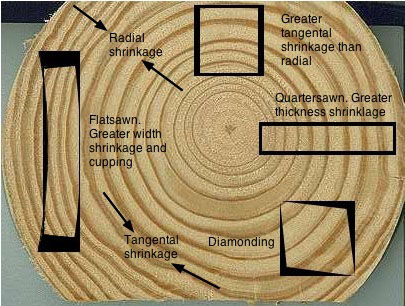Drying Hardwoods
Rules of thumb
- Slowing the drying rate reduces defects such as internal checking, collapse, case hardening and surface checking. However, if hardwood timber is dried too slowly sapstain and mould growth can discolour the timber.
- The thicker the timber, the longer the drying time, and the more difficult it is to dry without degrade. Internal checking is much more likely as thickness increases with higher shrinkage hardwoods. Where internal checking takes place ripping the timber to smaller sizes results in significant surface checking degrade.
Drying by species
Eucalypt
Eucalyptus nitens is the most difficult to dry and is particularly susceptible to checking, especially when not quartersawn. Also suffers from collapse, uneven shrinkage and resulting twisting. Requires slow drying and weighting.
Ash eucalypts (E. regnans, E. delegatensis, E. obliqua, E. fastigata and E. fraxinoides) are susceptible to some checking and collapse. These species should be quartersawn and dried slowly. E fastigata and E. fraxinoides have a reputation for drying easily without much degrade. Success with flatsawing has been reported.
Eucalyptus saligna, E. botryoides, E. pilularis, E. muelleriana and E. globoidea dry easily with little checking or collapse.
Southern beech
Southern beech should be dried slowly to avoid warp. Black beech dries with little cupping, even as wide flatsawn boards.
Pathological heartwood (often seen as black streaking through the sawn timber) is very slow to dry.
Fillets should be thin (10-16mm) and at a maximum spacing of 600mm. Stacks should be level at the ends with fillets right at the ends of the stacks.
Sap stain is not often a problem with beech species.
Higher density red beech from the North Island dries better than South Island lower density red beech.
Sapwood dries faster than heartwood. Drying can be patchy with some stock drying very slowly, requiring "equalising". Beech needs to be air-dried to below 30% moisture before kiln-drying.
Blackwood
Blackwood and Acacia generally season easily with little degrade.
Poplar
Poplar species generally season easily with little degrade.
Oak
Oak is difficult to season and should be dried slowly, in thin sections and weighted to avoid distortion and checking.
Seasoning flatsawn vs quartersawn timber
- The radial surface of timber dries faster. Flatsawn

i.e. milled with growth rings tangential to the wide faces. Flatsawn boards have greater width shrinkage and cupping, and dry faster. timber dries faster than quartersawn
i.e. milled with growth rings close to perpendicular to the wide faces of the board. Quartersawn boards have greater thickness shrinkage timber in the same conditions, but generally needs to be dried more slowly to minimise degrade. - Timber will shrink more tangentally

Tangental shrinkage is greater than radial, about twice as much as radially. Flatsawn boards are more prone to degrade such as surface checking and cupping
Cupping can be reduced by weighting the stack as it dries. However, such restraint can increase surface checking because of the stresses that cause cupping. than are quartersawn boards. - Crook
 can be an issue with quartersawn boards.
can be an issue with quartersawn boards.
Most cold-climate eucalypts are quartersawn due to their low radial shrinkage, and the timber then tends to dry slowly without much degrade. Hardwoods which can be seasoned easily are often flatsawn allowing wider boards to be cut from smaller trees and with faster drying times. However, cupping
Cupping can be reduced by weighting the stack as it dries. However, such restraint can increase surface checking because of the stresses that cause cupping. and movement in service are considerations with wide flatsawn boards.
Fibre saturation point
The initial stage of drying hardwoods aims to reach fibre saturation pointFibre saturation point: The moisture content at which moisture is saturated within the cell walls of wood and the cell cavities are free of water. Fibre-saturation point occurs at 25% MC to 32% MC depending on the species. Below FSP water is held in wood as bound water within the cell cavities or lumen. with minimal degrade. In practice this is best achieved with slow air drying. Once the centre part of the board reaches fibre saturation point it starts to shrink. There is now less tensile stress at the surface (which had previously shrunk) and the timber can now be dried more quickly with a kiln through to the required final moisture content.
Recovering collapse
Steam reconditioning is a process used to recover collapse and can close internal checking. It is not necessary where collapse has not taken place or is not excessive. Collapse, otherwise known as washboarding, is seen on the earlywood as excessive shrinkage. Tangental collapse, like tangental shrinkage, is about twice as great as radial collapse. Reconditioning involves heat and steam treatment which softens the fibre walls. The collapsed cells then recover much of their original shape and the board expands.
Reconditioning is carried out once all parts of the timber are below fibre saturation point (i.e. an average moisture content of around 18-20%). Higher moisture contents (where there is still free water in the cells) can increase checking and collapse, and cause case hardening. If the average moisture content is too low (below 15%) the process may have little effect. There should only be a small MC gradient between the core and the surface (no more than 5-7%)
The charge is heated with wet steam (i.e. at atmospheric pressure) to between 95-100º C and held there until the timber is heated all the way through. For 25 mm thickness timber this may be around 5-6 hours and for 50 mm thickness 7-8 hours, although in practice 90-120 minutes may achieve adequate core temperatures, depending on thickness and species. The timber must then be cooled slowly to ambient conditions.
Reconditioning generally adds between 1-2% MC to the timber. After reconditioning the timber is usually kiln dried.
Final kiln drying
Timber with different drying characteristics or different thicknesses cannot be dried in the same kiln charge without slowing overall drying, or risking degrade to the material requiring the slowest drying regime.
Because conventional kilns dry wood quite rapidly, moisture gradients may develop between the centre and surface of the board. This can cause residual stress which may then be relieved by a steam conditioning process. This is called "controlled final drying" and aims to equalise the moisture gradients thus improving the timbers stability in service.
Dehumidification kilns operate at low temperatures and thus drying rates are slow, producing low levels of degrade. Dehumidifiers are recommended for smaller operations and for "finishing" air-dried timber.
A "safe" schedule for dehumidifying air-dried timber (i.e. at fibre saturation point) is:
- Retain full humidity and heat to 39°C for 7 days.
- After 7 days start extracting moisture: reduce humidity to 75% for 4 days, then lower humidity again. Humidity should never be below 45% and temperature never above 40°C.
- Test moisture content at regular intervals with a moisture-meter and the charge can be removed when dried to the required moisture content (usually 10-12%).
Processing
For processing the timber should be stable, with the correct moisture content, an even moisture profile and minimal residual stress.
Storage
Moisture content of timber should not move outside the range for its intended use. The moisture content of dried timber will reach equilibrium with the ambient conditions of the surrounding environment. This should not change if the storage area is completely enclosed in an insulated building with temperature and humidity control.
Satisfactory storage may also be achieved if the storage area is completely enclosed in a building. This minimises air movement and eliminates uncontrolled sources of moisture.
If the storage area is only partially enclosed packs should be plastic wrapped. However, plastic wrapping only provides short-term protection from external conditions.
Also see Sawmilling Hardwoods - The Issues »
Further reading:
Australian Hardwood Drying Best Practice Manual
Seasoning of timber (pdf)
Disclaimer: While every effort is made to ensure the accuracy of the information provided on this site, Farm Forestry Timbers Society do not accept liability for any consequences arising from reliance on the information published. If readers have any doubts about acting on any articles they should seek confirming, professional advice.
 Farm Forestry New Zealand
Farm Forestry New Zealand Farm Forestry Timbers - Headlines
Farm Forestry Timbers - Headlines